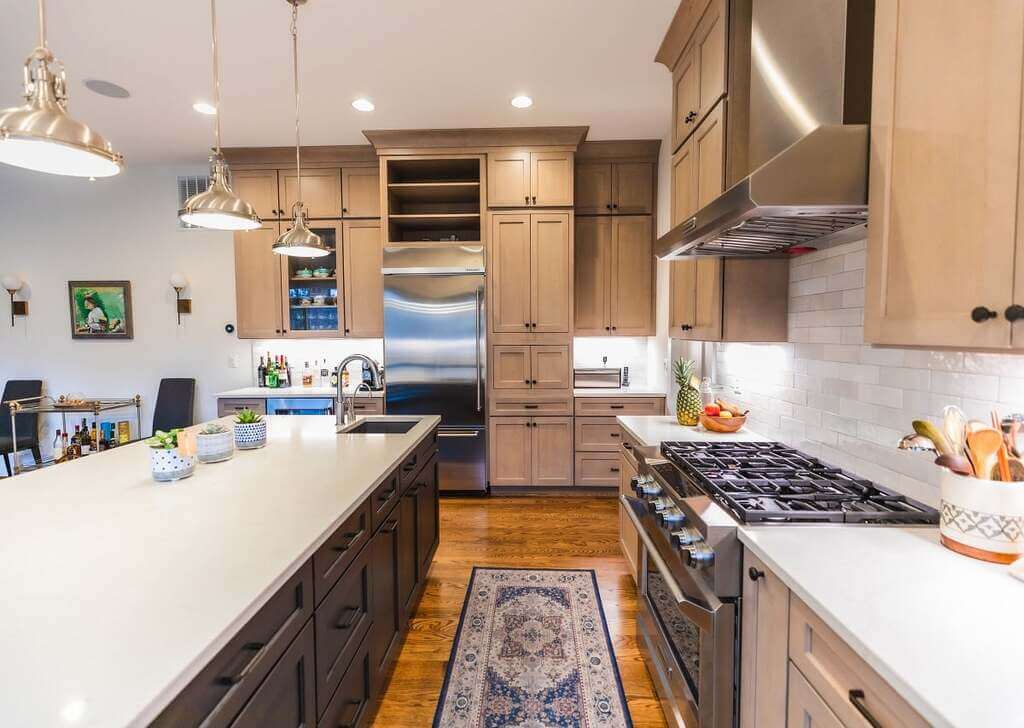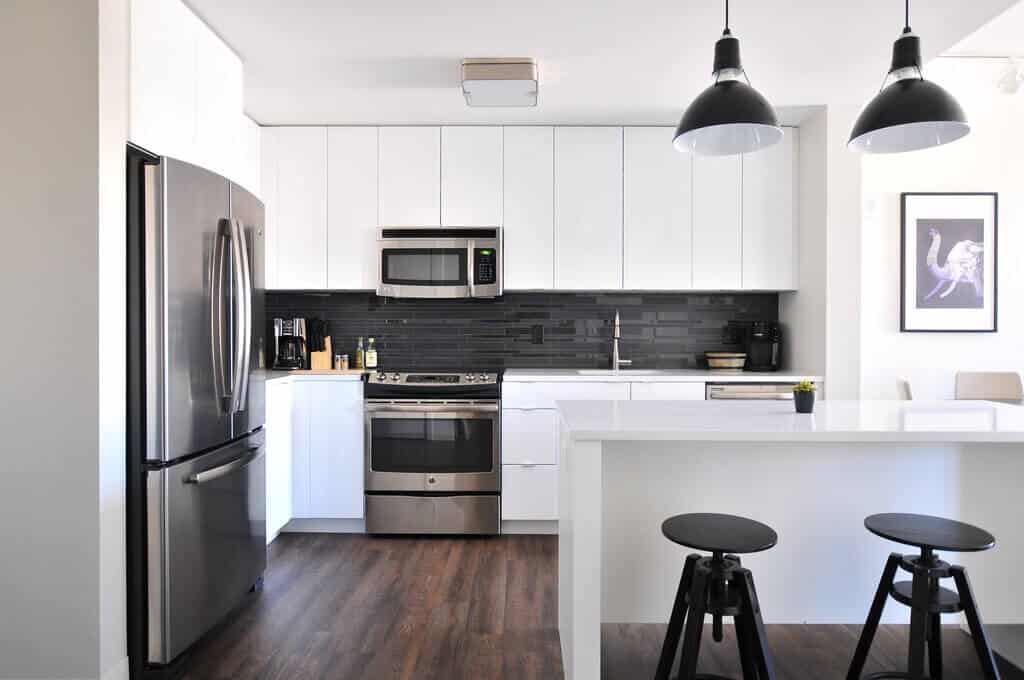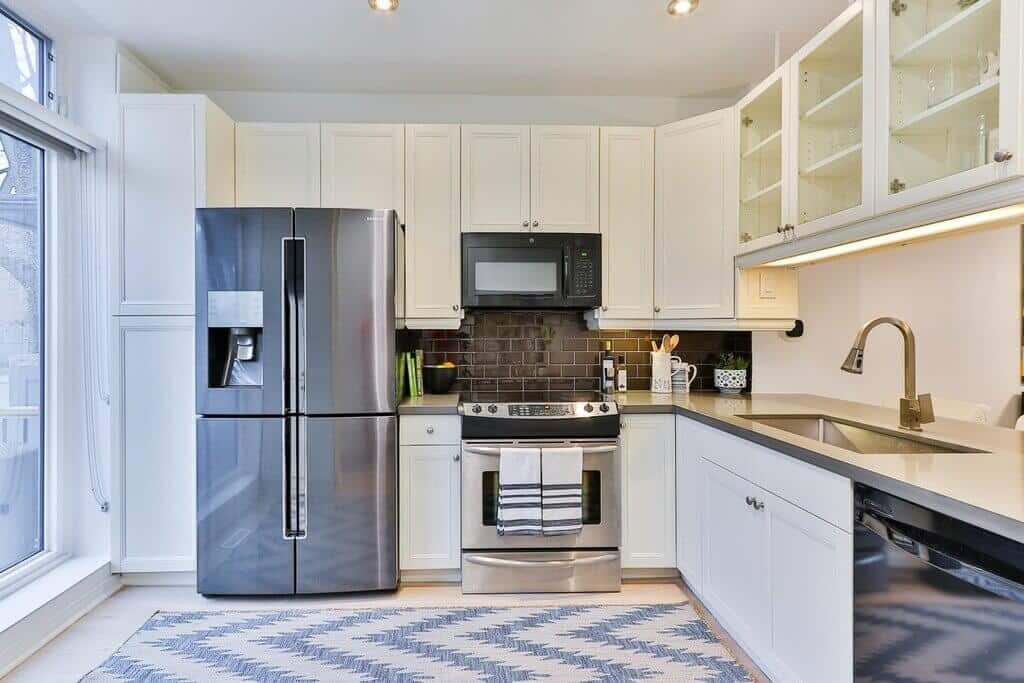A well-designed kitchen is the heart of any home, and kitchen remodels can significantly increase the value and functionality of your space. However, kitchen remodeling can be overwhelming and costly if you don’t avoid common pitfalls.
To help you navigate the process, we’ve gathered insights from architecture and design experts to bring you a list of the top kitchen remodeling mistakes to avoid.
Ignoring the Kitchen Work Triangle

The kitchen work triangle consists of the stove, refrigerator, and sink. These are the main work areas, and their placement is crucial for efficient workflow. To avoid congestion and maximize functionality, ensure that the distance between each point is between 4 and 9 feet and that they form a rough triangle. To avoid making this and other mistakes, use this printable kitchen remodel checklist.
Neglecting Storage Needs
One of the most common mistakes homeowners make is underestimating their storage needs.
Consider incorporating a variety of storage options, such as deep drawers, pull-out shelves, and built-in pantries. This will help you keep your kitchen organized and maximize your space.
Skimping on Countertop Space

Countertop space is essential for cooking, food preparation, and storage. Ensure you have ample countertop space near your main workstations, including the stove, refrigerator, and sink. Remember to allocate space for small appliances, such as a toaster, blender, or coffee maker.
Poor Lighting Design
Lighting is a critical aspect of kitchen design. Proper lighting can make your kitchen more functional, safe, and welcoming. Include a combination of task, ambient, and accent lighting.
Task lighting, such as under-cabinet lights, illuminates work areas, while ambient lighting provides overall illumination. Accent lighting highlights architectural features or artwork.
Overlooking Ventilation

Proper ventilation is essential to maintain good indoor air quality and prevent the buildup of smoke, odors, and grease.
Invest in a high-quality range hood that adequately removes cooking fumes and matches the size of your cooktop. Make sure the exhaust is vented outside and not simply recirculating the air.
Choosing Low-Quality Materials and Appliances
The kitchen is a high-traffic area, and you need durable materials and appliances that can withstand daily use.
Choosing low-quality materials and appliances might save you money initially, but they’ll likely need frequent repairs or replacement. Invest in high-quality countertops, cabinetry, and appliances that will last for years to come.
Focusing Too Much on Aesthetics

While creating a beautiful kitchen is essential, it’s equally important to prioritize functionality. Don’t let design trends dictate your choices at the expense of practicality.
Opt for a timeless design that suits your needs and lifestyle, and remember that you can always add personality with accessories and finishes.
Not Considering Workflow and Traffic Patterns
A well-planned kitchen layout can significantly improve your cooking experience. Consider how you move through the space while cooking and ensure that there is enough room for multiple people to work simultaneously.
Avoid placing appliances and fixtures in a way that interrupts the natural flow of traffic.
DIY-ing Complex Tasks

While some aspects of kitchen remodeling can be done on your own, certain tasks require professional expertise.
Plumbing, electrical work, and gas installations should be left to licensed professionals. Attempting these tasks without the necessary knowledge can lead to costly repairs or even dangerous situations.
Forgetting About a Budget
Kitchen remodeling projects can quickly become expensive if you don’t establish a budget upfront. Determine your budget before you start planning, and stick to it as closely as possible.
This will help you make informed decisions about materials, appliances, and other aspects of the project.
Inadequate Electrical Outlets

As the kitchen is a hub for cooking, entertaining, and charging various devices, it’s essential to have enough electrical outlets to accommodate all your needs. Homeowners often underestimate the number of outlets required, leading to a shortage and inconvenience when trying to use multiple appliances simultaneously.
Plan for sufficient outlets in convenient locations, and consider adding USB outlets for easy device charging.
Disregarding Universal Design Principles
Creating a kitchen that is accessible to people of all ages and abilities is not only considerate but also adds value to your home.
Incorporating universal design principles, such as installing lever-style door handles, having counters at varying heights, and ensuring ample maneuvering space, can make your kitchen more user-friendly for everyone, including those with limited mobility or physical challenges.
Failing to Allocate a Contingency Budget

No matter how well you plan your kitchen remodel, unforeseen issues or changes in plans can arise during the process. Failing to allocate a contingency budget can leave you scrambling to cover additional expenses and potentially compromise the quality or scope of your project.
By setting aside an extra 10-15% of your overall budget for unexpected costs, you can ensure a smoother remodeling experience and be prepared to handle any surprises that may come your way.
In Conclusion
Undertaking a kitchen remodel is an exciting opportunity to enhance the value, functionality, and aesthetics of your home. By being mindful of these common mistakes and drawing on the wisdom of architecture and design experts, you can create a kitchen that truly reflects your personal taste and lifestyle.
Keep in mind the importance of the work triangle, storage, counter space, professional consultation, and the additional points covered in this article to achieve a kitchen remodel that is both enduring and practical.
Discover More:

